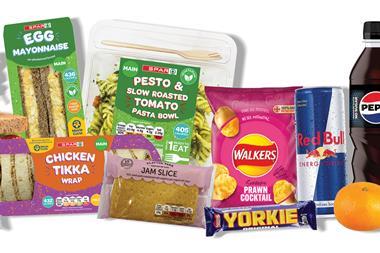Many c-stores are under increasing pressure to cut customers’ queue times. Here C-Store looks at how retailers are investing in speedy service
In today’s ultra-convenient, smartphone-enabled world, consumers expect instant gratification. Whether it’s ordering a pizza, watching the latest hit US drama, or reading the news, so many daily needs can now be met at the touch of a button. Unsurprisingly, this ‘want it now’ attitude now applies to food shopping, where waiting in line to pay for goods is fast becoming a powerful deal-breaker.
“Shoppers hate to queue,” asserts a spokesman for queue management specialist Irisys. “Extensive research proves that queuing at the checkout is the number one cause of customer dissatisfaction in retailing. Conversely, short queues - and critically, the expectation of short checkout queues - are key ways to build customer loyalty and encourage spending.”
In fact, today’s customers despise queuing to such an extent that as many as 56% say they would not return to a store after a bad queuing experience, research from retail software provider Omnico shows.
For these shoppers, the recent explosion of ‘pay-in-aisle’ technology, which allows customers to skip physical checkouts altogether, must be music to their ears.
One of the most widely talked about shop-and-go concepts of 2018 is Amazon Go. While still only on trial in the US, it allows shoppers with an Amazon account and the Amazon Go app installed on their smartphones to ‘just walk out’ when they’re finished shopping.
Sensors on shelves work with ceiling-mounted cameras to identify customers as they move around the store, automatically adding items to their bill as they pick them up, and deleting any that they put back. Their Amazon account is charged for the goods on leaving the store.
And it’s not just Amazon dipping its toes into the checkout-free arena. A raft of exciting technological trials are also taking place right here in Blighty.
Just last month, the Co-operative Group announced that it was trialling a new ‘frictionless shopping experience’ app, which allows customers to pay for purchases on their phones without visiting a checkout.
The ‘shop, scan and go’ initiative allows customers to scan products on their smartphone as they walk the store. When they have finished shopping, the amount they owe is then deducted from their account with a single click.
Barclaycard is trialling a similar payment concept via its Grab+Go app, while Sainsbury’s is testing a checkout-free app in its store at London’s Euston station with customers who are purchasing its £3 On the Go meal deal.
But while checkout-free stores are likely to play a significant role in shaping customers’ service experience going forward, they certainly aren’t the future for all stores. Instead, contactless technology (which celebrated its 10th birthday in 2017) is continuing to have a positive impact on service times at conventional checkouts, now saving an average of seven seconds per transaction compared with Chip and PIN, and 15 when compared with cash, Barclaycard claims.
More than half (55%) of consumers choose to pay with contactless technology because, they say, it saves them time, and queueing has been reduced as a result, with 52% of shoppers agreeing that they are now served more quickly at the till thanks to contactless.
Contactless payments across credit and debit cards saw continued momentum in 2017, with contactless spending in convenience stores specifically having grown by 46% last year, according to new Barclaycard data.
And the rising use of contactless is helping to boost the fortunes of another speedy service enabler, the self-service checkout (SSCO).
SSCOs are becoming increasingly commonplace in high-footfall, urban convenience stores where, when used alongside traditional manned checkouts, retailers are reporting serious service wins.
SSCOs have made great strides in recent years and are now a long way away from the oversized, clunky and confusing machines of old, points out Melanie Osborne, head of marketing at HTEC, which has two SSCO options suitable for convenience stores.
“In 2018, SSCOs for convenience stores are smaller, faster and more intuitive than ever before, leading a great many retailers to install units alongside traditional manned till points,” she says.
HTEC’s convenience products include a standalone model for small baskets, while the other is a clever desktop model which can function either as a SSCO when faced towards the customer, or as a manned checkout to be used by staff when faced towards the counter.
Paul Gardner last year introduced five SSCOs as part of a refit of his busy Budgens store in Islington, North London, and this month the equally busy Costcutter store on Brunel University’s campus in London will be introducing three SSCOs, with the possibility of adding two more this summer. The SSCOs will complement the existing five manned checkouts.
Store manager Arnaud Ledjou explains: “We are a university store, so speed of service is very important. Our business peaks at lunchtime and between lectures, meaning students and staff have a limited time to grab a snack or meal.
“Our average queue time is currently about three minutes at the lunchtime peak and we would like to reduce that to a maximum of two,” he says.
“We are hopeful that the new SSCO will have a two-fold benefit: speeding up service times; and increasing footfall and sales even further as a result,” he adds.
In fact, the additional SSCOs are projected to lead to a 10% sales increase, meaning that Arnaud’s store could achieve a return on his investment in just six months.
However, any notion that SSCOs will mean retailers can employ fewer staff is dashed by HTEC’s Osborne. “SSCOs work best alongside traditional manned checkouts at peak times, but at quieter times they can also free staff up to do other in-store jobs, such as stacking shelves or helping customers on the shop floor. Poor on-shelf availability is a major gripe for shoppers, particularly in busy stores, and often leads to more time being wasted while shoppers wait for staff to assist them.
“Having an SSCO enables stores to redeploy staff to other areas where they are needed more, which in turn can also speed up service and create a better shopping experience,” she adds.
Another way of speeding up service is using handheld iPad or tablet payment terminals, which allow staff to serve customers wherever they are on the shop floor and not just at fixed till points. It’s a system that may hold potential for c-stores.
Independent CTN store Farrants in Cobham, Surrey, currently has one iPad which it uses as a handheld payment device, although its use is primarily restricted to the store’s dedicated tobacco room, rather than out on the shop floor. Office manager James Hardaker says: “Although it was our goal to enable staff to be able to walk the queue and be able to serve, the practicalities such as how do staff keep carrier bags on their person, hold an iPad in one hand, a scanner in the other and still serve, have made this unworkable for us,” James says.
However, careful consideration of the store’s new software systems have helped it to rack up notable service wins since its 2016 refurb.
“Identifying exactly where to invest technology budgets and reduce latency within systems is key to speeding up service,” James explains. “Fast, powerful computers with top-quality scanners and a fast, stable internet connection were key for us.
“We could have invested a lot less, but system speed is so important when you have a queue. Customers just aren’t happy to queue for a Mars bar anymore!
“If using wi-fi to connect iPads to the internet, it’s also vital to invest in quality wi-fi gateways,” he adds. “The wi-fi provided from your internet box just won’t cut the mustard. Wi-fi gateways are faster, with reduced latency and are much more stable.”
Old school
There are, of course, a wealth of non-technological ways of speeding up service, starting with staff training. “The more the staff know and understand about how the business works, the more efficient they can be when interacting with customers,” James adds.
“We like to chat and engage with our customers, but when there’s a queue we need to move them through the tills as quickly as possible,” he continues.
“Being able to politely move on a customer who is used to a chat can be a bit of an art form! Knowing when to upsell and when not to is also important.”
And despite the growing ‘want it now’ culture, there are still a great many stores and customers for whom speed of service is not a critical requirement, and where a chat over the counter as the groceries are bagged is highly valued.
The real key to success is giving customers choice, and for those who demand speedy service, offering faster ways to pay, pays.
Biometric Payments

Costcutter Brunel University store in London is the first in the UK to have introduced Fingopay - a cutting-edge payment solution that allows customers to pay for their goods with a touch of their finger.
The system takes a detailed scan of the three main veins in customers’ fingers to create a unique 3D pattern. Unlike fingerprints this biometric identifier can’t be damaged, stolen or forged, and once shoppers have signed up with their bank details payments are verified in seconds, or at the touch of a finger on the store’s counter-top scanner.
Since launching in October 2017, almost 2,000 store customers have signed up, with numbers growing each day.
The solution is having a dramatic impact on queuing times by speeding up service, and customers say it’s easier for them not having to carry a wallet around on campus.
Footfall has also grown by 11% since the launch.
Fingopay customers can view their transactions via an app on their phone and store manager Arnaud Ledjou is currently working with the team at Fingopay to launch a new marketing platform which will enable him to text and email customers with bespoke deals and promotions based on their buying habits.
Technology

Will self-serve checkouts work for you?
Not all stores are the right fit for a self-service checkout (SSCO). HTEC’s Melanie Osborne has some helpful advice to weigh up whether a SSCO is right for you and your customers.
SSCOs work best in busy stores with a high volume of young customers. Younger people are generally more willing to use an SSCO and less worried about using contactless payment methods, which is driving SSCO innovations and usage.
SSCOs also work particularly well in stores that get peaks in footfall, such as stores near schools, universities or stations.
SSCOs are particularly effective in stores with small average basket spend; where people are dashing in to buy a lunchtime meal deal of just four or five items, for example. For these people, speed of service is paramount and the self-checkout really comes into its own.
SSCOs also work better when the items bought are packaged and can be scanned easily. If you sell a high proportion of standard, barcoded items, then an SSCO is likely to be more successful.
You should also consider your store’s card/cash ratio: SSCOs tend to be more popular in stores where the card payment ratio is high.
Items such as alcohol and tobacco require approval assistance and customers buying those items will still have to wait for a member of staff to approve them. If your store has a high number of customers who buy these items, then SSCOs can work - but only as long as there is a member of staff dedicated to this and getting the customer through the process quickly.




























1 Readers' comment